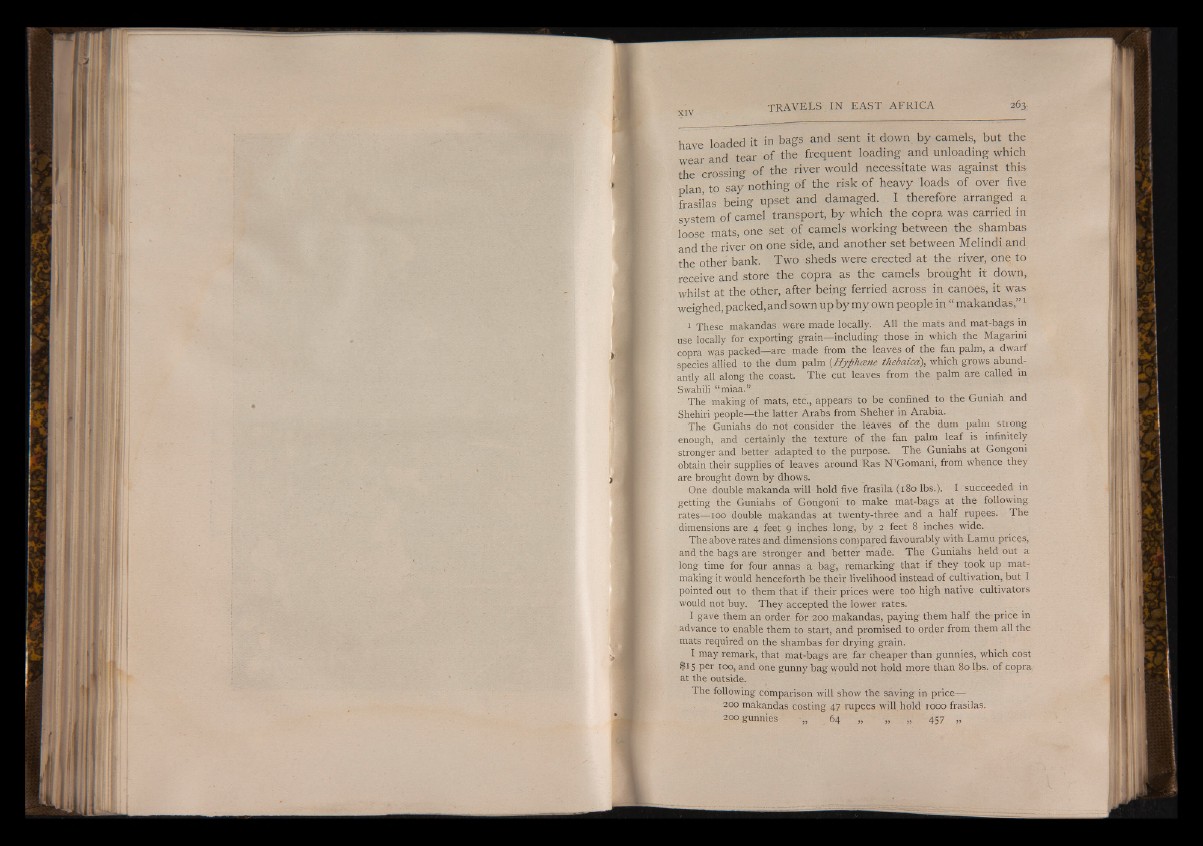
have loaded it in bags and sent it down, by camels, but the
wear and tear of the frequent loading and unloading which
the crossing of the river would necessitate was against this
plan, to say nothing of the risk of heavy loads of over five
frasilas being upset and damaged. I therefore arranged a
system of camel transport, by which the copra was carried in
loose mats, one set of camels working between the shambas
and the river on one side, and another set between Melindi and
the other bank. Two sheds were erected at the river, one to
receive and store the copra as the camels brought it down,
whilst at the other, after being ferried across in canoes, it was
weighed, packed,and sown up by my own people in “ makandas,” 1
1 These makandas were made locally. All the mats and mat-bags in
use locally for exporting grain— including those in which the Magaririi
copra was packed—are made from the leaves of the fan palm, a dwarf
species allied to the dum palm {Hyfthtzne thebaica), which grows, abundantly
all along the coast. The cut leaves from the palm are called in
Swahili “miaa.”
The making of mats, etc., appears to be confined to the Guniah and
Shehiri people— the latter Arabs from Sheher in Arabia.
The Guniahs do not consider the leaves of the dum palm strong
enough, and certainly the texture of the fan palm leaf is infinitely
stronger and better adapted to the purpose. The Guniahs at Gongoni
obtain their supplies of leaves around Ras N’Gomani, from whence they
are brought down by dhows.
One double makanda will hold five frasila (180 lbs.). I succeeded in
getting the Guniahs of Gongoni to make mat-bags at the following
rates— 100 double makandas at twenty-three and a half rupees. The
dimensions are 4 feet 9 inches long, by 2 feet 8 inches wide.
The above rates and dimensions compared favourably with Lamu prices,
and the bags are stronger and better made. The Guniahs held out a
long time for four annas a bag, remarking that if they took up mat-
making it would henceforth be their livelihood instead of cultivation, but I
pointed out to them that if their prices were too high native cultivators
would not buy. They accepted the lower rates.
I gave them an order for 200 makandas, paying them half the price in
advance to enable them to start, and promised to order from them all the
mats required on the shambas for drying grain.
I may remark, that mat-bags are far cheaper than gunnies, which cost
$15 per 100, and one gunny bag would not hold more than 80 lbs. of copra
at the outside.
The following comparison will show the saving in price—?
200 makandas costing 47 rupees will hold 1000 frasilas.
200 gunnies ■„ , 64 ,, ' •„ „ 457